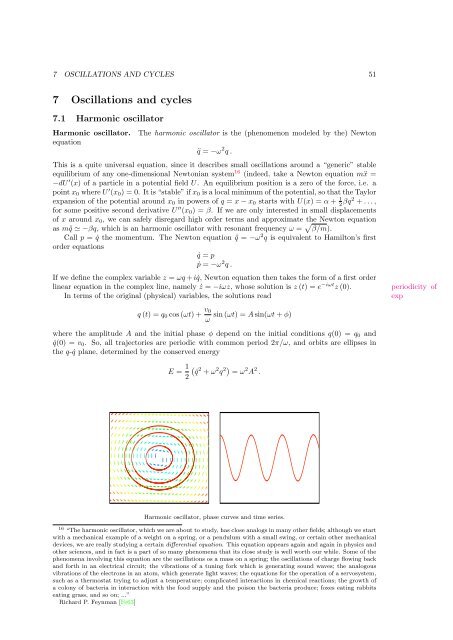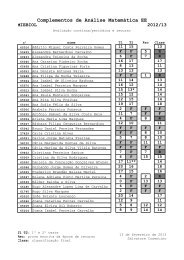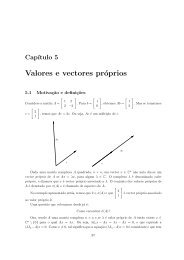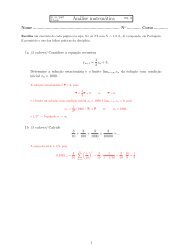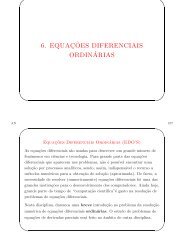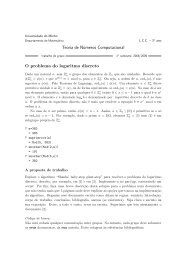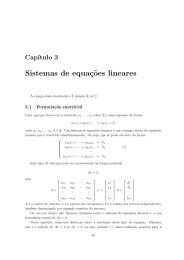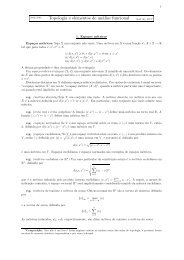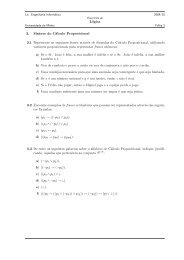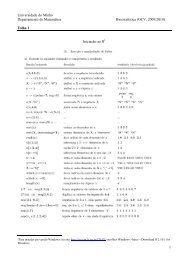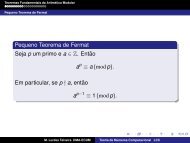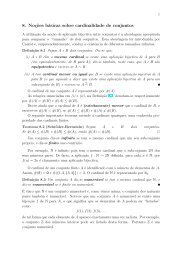My title - Departamento de Matemática da Universidade do Minho
My title - Departamento de Matemática da Universidade do Minho
My title - Departamento de Matemática da Universidade do Minho
Create successful ePaper yourself
Turn your PDF publications into a flip-book with our unique Google optimized e-Paper software.
7 OSCILLATIONS AND CYCLES 51<br />
7 Oscillations and cycles<br />
7.1 Harmonic oscillator<br />
Harmonic oscillator.<br />
equation<br />
The harmonic oscillator is the (phenomenon mo<strong>de</strong>led by the) Newton<br />
¨q = −ω 2 q .<br />
This is a quite universal equation, since it <strong>de</strong>scribes small oscillations around a “generic” stable<br />
equilibrium of any one-dimensional Newtonian system 16 (in<strong>de</strong>ed, take a Newton equation mẍ =<br />
−dU ′ (x) of a particle in a potential field U. An equilibrium position is a zero of the force, i.e. a<br />
point x 0 where U ′ (x 0 ) = 0. It is “stable” if x 0 is a local minimum of the potential, so that the Taylor<br />
expansion of the potential around x 0 in powers of q = x − x 0 starts with U(x) = α + 1 2 βq2 + . . . ,<br />
for some positive second <strong>de</strong>rivative U ′′ (x 0 ) = β. If we are only interested in small displacements<br />
of x around x 0 , we can safely disregard high or<strong>de</strong>r terms and approximate the Newton equation<br />
as m¨q ≃ −βq, which is an harmonic oscillator with resonant frequency ω = √ β/m).<br />
Call p = ˙q the momentum. The Newton equation ¨q = −ω 2 q is equivalent to Hamilton’s first<br />
or<strong>de</strong>r equations<br />
˙q = p<br />
ṗ = −ω 2 q .<br />
If we <strong>de</strong>fine the complex variable z = ωq + i ˙q, Newton equation then takes the form of a first or<strong>de</strong>r<br />
linear equation in the complex line, namely ż = −iωz, whose solution is z (t) = e −iωt z (0).<br />
In terms of the original (physical) variables, the solutions read<br />
periodicity of<br />
exp<br />
q (t) = q 0 cos (ωt) + v 0<br />
ω<br />
sin (ωt) = A sin(ωt + φ)<br />
where the amplitu<strong>de</strong> A and the initial phase φ <strong>de</strong>pend on the initial conditions q(0) = q 0 and<br />
˙q(0) = v 0 . So, all trajectories are periodic with common period 2π/ω, and orbits are ellipses in<br />
the q- ˙q plane, <strong>de</strong>termined by the conserved energy<br />
E = 1 2<br />
(<br />
˙q 2 + ω 2 q 2) = ω 2 A 2 .<br />
Harmonic oscillator, phase curves and time series.<br />
16 “The harmonic oscillator, which we are about to study, has close analogs in many other fields; although we start<br />
with a mechanical example of a weight on a spring, or a pendulum with a small swing, or certain other mechanical<br />
<strong>de</strong>vices, we are really studying a certain differential equation. This equation appears again and again in physics and<br />
other sciences, and in fact is a part of so many phenomena that its close study is well worth our while. Some of the<br />
phenomena involving this equation are the oscillations os a mass on a spring; the oscillations of charge flowing back<br />
and forth in an electrical circuit; the vibrations of a tuning fork which is generating sound waves; the analogous<br />
vibrations of the electrons in an atom, which generate light waves; the equations for the operation of a servosystem,<br />
such as a thermostat trying to adjust a temperature; complicated interactions in chemical reactions; the growth of<br />
a colony of bacteria in interaction with the food supply and the poison the bacteria produce; foxes eating rabbits<br />
eating grass, and so on; ...”<br />
Richard P. Feynman [Fe63]


